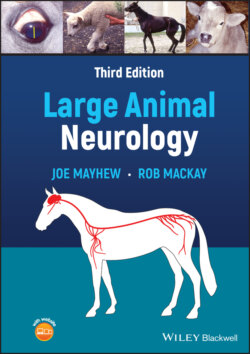Читать книгу Large Animal Neurology - Joe Mayhew - Страница 101
Neoplasms and other tumors
ОглавлениеWith the exception of neurofibroma and lymphosarcoma in cattle, neoplasms involving nervous tissue are rare in domestic large animals. Neoplasms replace and compress nervous tissue, and both forms of intrusion often cause adjacent edema because of local vascular perturbations. Indeed, vascular compromise can result in considerable necrosis of CNS tissues as well as of the tumor itself. As a result of the space‐occupying effect and any associated edema, brain herniations occur with brain neoplasms just as they occur with cerebral abscesses and hematoma. These include herniations of the cingulate gyrus under the falx cerebri, the occipital lobes under the tentorium cerebelli, and the cerebellar vermis through the foramen magnum (Figures 4.8 and 4.10). All these tissue movements cause compression of parts of the brain. Primary CNS tumors are extremely rare in large animals, but can arise from meningeal, ependymal, choroidal, glial, and endothelial cell lines. Neuronal cell line neoplasms are even less frequently encountered. However, a proliferation of primitive neuroepithelial cells from the late developing brain sometimes occurs in young patients as a medulloblastoma. Ganglion and Schwann cell neoplasms occur in the PNS. Neoplasms involving the skull and vertebrae as well as metastatic neoplasms usually compress nervous tissue, the effects being identical to those of external injury. Lymphosarcoma probably is the most common neoplasm involving the brain and spinal cord in large animals, and probably it should be considered a primary tumor when it is in the epidural space and when it encompasses the peripheral nerves of cattle.
There is an interesting group of neural tumors that include usually focal, disorganized proliferation of normal neural and other tissue elements in abnormal groupings or abnormal sites, collectively referred to as hamartomas.31–33 These expansile tissue masses disrupt the function of adjacent neural tissues without usually causing tissue destruction.
